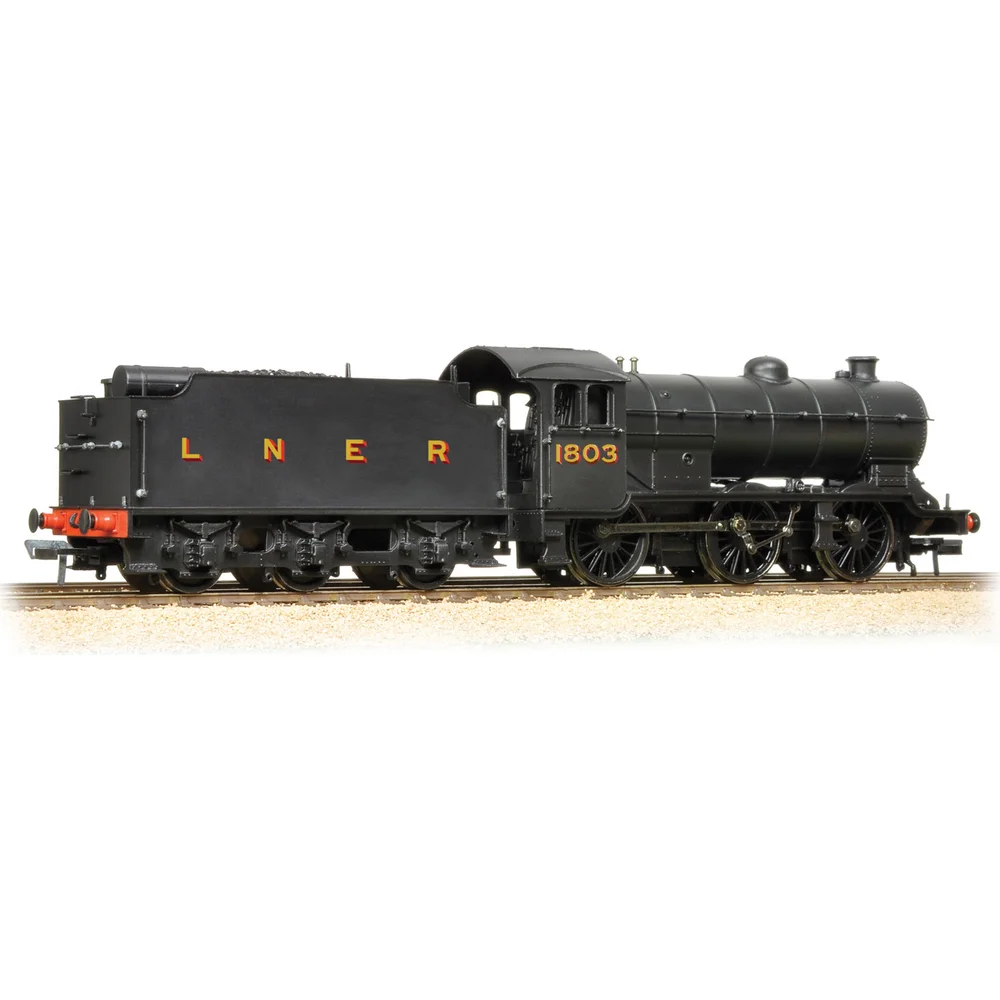Bachmann 31-866
London & North Eastern Railway J39 1803 London & North Eastern Railway Black
Tooling
In 2015, Bachmann announced a major upgrade to its LNER Class J39 model, replacing the original 1994 split-chassis tooling. The retooled version reflected modern standards in OO gauge locomotive design, addressing long-standing issues such as DCC incompatibility and limited electrical pickup. The prototype J39, designed by Sir Nigel Gresley, was a versatile mixed-traffic 0-6-0 locomotive built between 1926 and 1941, widely used across the LNER and later British Railways until withdrawal in the early 1960s.
Tooling Features
- Scale: OO gauge (1:76)
- Construction: All-new chassis with wiper pickups, plastic body with fine detailing
- Detailing: Separately fitted handrails, lamp brackets, vacuum pipes, cab glazing, and accurate tender variations
- Couplings: NEM pockets with slim tension-lock couplers
- Tender Options: Flat-sided and stepped tenders, matching prototype variations
Mechanical & Electrical
- Drive: Modern chassis with centrally mounted motor driving all coupled wheels
- Motor: Smooth-running can motor with improved gearing for slow-speed control
- Minimum Radius: Suitable for second radius curves (approx. 438 mm)
- Lighting: No factory-fitted lighting
- Weighting: Balanced for traction without excessive mass
- Pickups: Full wiper pickups on locomotive and tender for reliable current collection
DCC Capability
- DCC Ready: Equipped with a 21-pin MTC socket for easy decoder installation
- Sound: Space provided for speaker installation in the tender for sound upgrades
Liveries Produced
- LNER Black (pre-war)
- BR Black with Early Emblem
- BR Black with Late Crest
- Weathered and pristine finishes offered across catalogue numbers
Reviews & Commentary
The 2015 upgrade was widely praised for bringing the J39 up to contemporary standards. Reviewers highlighted the improved chassis, reliable pickups, and ease of DCC conversion. Detailing was considered crisp and accurate, while performance tests showed smooth running and strong haulage. Criticism was minimal, mainly noting the absence of factory lighting and sound.
Media & Social Media
Model railway forums and YouTube reviews welcomed the retooled J39 as a significant improvement over the original split-chassis version. Enthusiasts noted its suitability for both freight and passenger layouts, and conversion guides for sound fitting became popular among hobbyists.
Interesting Notes
- The 2015 tooling marked the end of Bachmann’s reliance on split-chassis technology for steam models
- The upgrade coincided with a broader program of modernizing older Bachmann steam locomotive designs
Class & Prototype
- Class: London & North Eastern Railway J39
- Traction: Steam
- Built: 1926-1941
- Total Built: 289
- Running Number: 1803
Operator & Livery
- Operator: London & North Eastern Railway
- Livery: Black
- Era: 3 - The big 4 – LMS, GWR, LNER & SR
The London & North Eastern Railway emerged in 1923 as Britain's second-largest railway company, combining seven major railways including the Great Northern, North Eastern, and Great Eastern into a 6,590-mile network stretching from London's four terminals to the Scottish Highlands. Despite serving economically challenged industrial regions, the LNER achieved worldwide recognition for engineering excellence and speed records that remain unbroken today.
Under Chief Mechanical Engineers Sir Nigel Gresley, Edward Thompson, and Arthur Peppercorn, the LNER developed revolutionary locomotive designs characterised by three-cylinder layouts and streamlined aesthetics. Gresley's masterpieces included the A1 Pacifics featuring Flying Scotsman and the legendary A4 class, culminating in Mallard's world steam speed record of 126 mph in 1938.
The company pioneered luxury express services including the Silver Jubilee and Coronation streamliners, whilst investing in forward-thinking electrification schemes and massive marshalling yards. Notable achievements included operating the complete East Coast Main Line, introducing Britain's first regular 400-mile non-stop service, and commissioning Eric Gill's iconic typography that influenced railway design for decades.
Nationalised in 1948, LNER locomotives continued serving British Railways until the 1960s, with some A4 Pacifics working Scottish expresses until 1966. Today, the LNER's engineering legacy thrives through extensive preservation, new-build projects like Tornado, and comprehensive model ranges covering every major class in all popular scales, making LNER subjects essential for discerning railway modellers seeking authentic British steam-age atmosphere.
The LNER plain black livery emerged as a practical economy measure that ultimately became the most widely applied colour scheme in the company's history. Initially introduced for goods engines in 1928 to reduce painting costs and labour time, this austere unlined black finish dispensed with decorative red lining whilst retaining the basic yellow lettering and "L N E R" tender markings. The livery reflected the harsh economic realities facing the LNER, particularly as the company served Britain's struggling industrial regions during the depression years of the 1930s.
The plain black scheme reached its zenith during World War II when, from 1941 onwards, austerity measures mandated that all locomotive classes receive unlined black paint regardless of their previous prestigious liveries. The transformation was dramatic – even the magnificent streamlined A4 Pacifics like Mallard and Flying Scotsman were painted in stark black, their elegant engineering unchanged but their glamorous appearance replaced by wartime utility. The austerity deepened in October 1943 when tender lettering was reduced from "L N E R" to simply "N E", halving material usage and painting time whilst creating one of the most recognisable images of Britain's wartime railways. For modellers, this livery authentically represents the challenging economic and wartime periods, offering dramatic visual impact and historical accuracy when depicting late 1920s freight operations, 1930s depression-era scenes, or the austere years of 1941-1947 when Britain's railways prioritised function over form.
